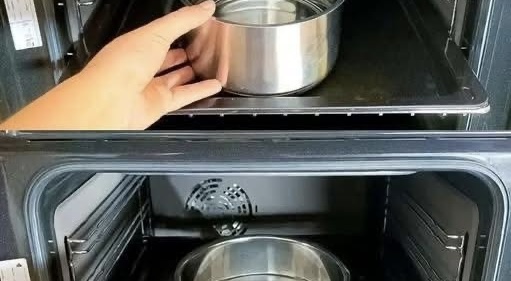Moist heat is one of the most powerful tools in your kitchen, and placing a pot of water inside your oven can transform how your oven performs. Whether you want to clean it more easily, improve your baking results, or restore humidity after long roasting sessions, this method is simple, effective, and beginner-friendly.
How the Trick Works
When you place a heat-safe pot filled with water into a hot oven, the water gradually transforms into steam. This steam increases the humidity inside the oven cavity. Moist heat loosens dirt, softens baked-on grease, enhances baking textures, and equalizes heat distribution. It’s one of the easiest ways to improve oven performance without chemicals or expensive tools.
Why You Should Try This Method
There are several practical benefits, and each one can improve a different part of your cooking or cleaning routine.
1. Naturally Loosen Grease and Burnt Residue
One of the most frustrating kitchen chores is scrubbing an oven full of dried, hardened grease. Steam softens these residues, making them wipe away with minimal effort. By heating a pot of water to create a steamy environment, you turn hours of scrubbing into a few minutes of wiping.
To use this for cleaning:
• Preheat your oven to about 230°C (450°F).
• Place a large, oven-safe pot or bowl of water onto the center rack.
• Let it steam for 20 to 30 minutes.
• Turn off the oven and let it cool slightly.
• Wipe down the sides and bottom with a cloth or sponge.
The steam loosens grease that would normally require oven cleaner or heavy scrubbing.
2. Improve the Texture of Homemade Bread
Professional bakers often create steam in their ovens to achieve crisp, glossy crusts. The steam delays the formation of the outer crust, allowing the dough to rise taller and bake more evenly. If your homemade bread collapses or turns out dense, this trick can change everything.
For bread baking:
• Preheat the oven with your pot of water already inside.
• When the dough goes in, the moist environment ensures better oven spring.
• Remove the pot halfway through to finish the crust.
This method works beautifully for baguettes, sourdough, dinner rolls, and rustic loaves.
3. Restore Moisture in Long Baking or Roasting Sessions
Roasting meats, casseroles, or vegetables for long periods can dry out the air inside the oven. Adding a pot of water maintains humidity and prevents the surface of food from drying too quickly.
You can especially benefit when cooking:
• Whole chicken or turkey
• Slow-roasted pork shoulder
• Lasagna and baked pasta
• Casseroles or gratins
• Stuffed vegetables
• Baked fish
A moist oven environment helps food stay tender and juicy while still allowing proper browning.
4. Better Heat Distribution for Even Cooking
Dry heat can create hot spots in your oven. Steam increases overall air density, helping heat move more effectively around your dish. This results in more even baking and fewer undercooked or overcooked areas.
If you notice:
• Cakes rising unevenly
• Cookies browning too fast on one side
• Roasts cooking unevenly
• Pans scorching on the bottom
This technique can improve performance without adjusting temperatures.
5. A Chemical-Free Method to Refresh Your Oven
Sometimes your oven just smells unpleasant after cooking strong foods such as fish, onions, or roasted meats. Steam helps eliminate odors by lifting small deposits that cling to the oven walls. Adding lemon slices or vinegar to the water enhances the effect.
Try this simple refresh:
• Fill the pot with water
• Add lemon slices, vinegar, or baking soda
• Heat the oven to create scented steam
• Let the oven cool and wipe down
It leaves the oven smelling fresh without harsh cleaners.
How to Do It Safely
Although the method is easy, there are simple precautions to keep in mind.
• Always use an oven-safe pot or dish
• Do not use glass cold from the fridge (risk of shattering)
• Avoid overfilling the pot
• Be careful of steam when opening the oven door
• Use oven mitts for handling hot containers
• Keep the water away from heating elements
Never place plastic containers inside the oven, even at low temperatures.
When You Should Not Use This Method
A steam pot is helpful in most cases, but there are situations where it’s unnecessary or counterproductive:
• When trying to crisp foods like fries or chicken wings
• When baking cookies or brownies that require dry heat
• When using self-cleaning oven cycles
• With certain delicate pastries that collapse with steam
For most everyday cooking and cleaning, however, the method is safe and effective.
Final Thoughts
Placing a pot of water inside your oven is one of the simplest kitchen tricks that delivers big results. From loosening stubborn grease to improving bread texture and balancing oven heat, steam can make your cooking easier and your cleaning faster. It’s a low-cost, beginner-friendly technique that anyone can use, and once you try it, it will likely become part of your regular kitchen routine.
